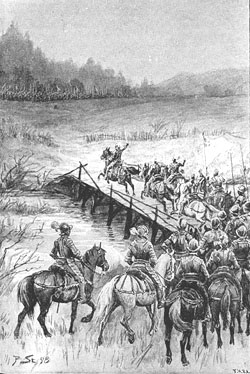Battle of Stångebro
This article needs additional citations for verification. (March 2007) |
| Battle of Stångebro | |||||||
|---|---|---|---|---|---|---|---|
| Part of War against Sigismund and the prelude to the Polish-Swedish War of 1600–1611 | |||||||
 | |||||||
| |||||||
| Belligerents | |||||||
|
| commander1=King Sigismund | ||||||
| Commanders and leaders | |||||||
| Duke Charles | |||||||
| Casualties and losses | |||||||
| 2000 killed | Unknown | ||||||
The Battle of Stångebro or Battle of Linköping took place at Linköping, Sweden on September 25, 1598, and effectively ended the personal union between Sweden and the Polish-Lithuanian Commonwealth, that had only existed since 1592. In the battle, an army of 12,000 commanded by Duke Charles defeated an army of 8,000 commanded by King Sigismund. It was the beginning of the Polish-Swedish War.
Background
Main articles: Foundation of Modern Sweden, Polish-Swedish union and Sigismund III Vasa
When King John III of Sweden died in 1592, his son Sigismund inherited the throne, despite his Catholic upbringing and despite already being King of Poland-Lithuania. However, he was refused coronation unless he agreed to the conditions of a clerical convention in Uppsala, making Sweden decisively Protestant. The debate was resolved in 1594, and freedom of religion was proclaimed, although only Protestants could hold high offices. The Swedish nobility also sought greater freedom and privileges. They were not granted these, but in the absence of the king, who spent most of his time in Poland, Sweden was to be ruled jointly by the Privy Council and Sigismund's uncle, Duke Charles. At the Riksdag in Söderköping, summoned against the will of the king, Duke Charles was elected regent in the king's absence. This was protested by Sigismund and those nobles loyal to him (mostly found in Finland after the king's governor, Klaus Fleming, had put down a peasant uprising there).
Duke Charles sought to end the conflict by military means, but gained little support within the Privy Council. The new Riksdag he summoned at Arboga in 1597 – again despite the king's orders – saw few participants, and only one from the Privy Council. Even so, he did not receive support for military action, but initiated it nonetheless. Parts of southern Sweden were taken. Several of the Privy Council members fled to Poland to convince Sigismund to take counteraction.
During the summer of 1598, Sigismund's fleet took back Kalmar and continued northward. The force won a battle against the troops of Duke Charles at Stegeborg[1] but soon found itself encircled and retired to Linköping. The support Sigismund had counted on from the Swedish people did materialize to some extent, splitting the Swedish armed forces in two hostile fractions.
The battle
Stångebro is an area around two old bridges over the river Stångån, Stora Stångebro and Lilla Stångebro. Today it is a central part of Linköping, but in the 16th century the city did not extend east of the river. When the forces of Duke Charles approached from the east on the morning of September 25, Sigismund's army charged out of the city and met them at these bridges. A thick fog was instrumental at hiding the troop movements from their respective enemies. Both armies included small sections of cavalry.
The duke was the first to attack. He won a quick victory at Stora Stångebro and moved over his troops to Lilla Stångebro, where Sigismund's forces had reached the eastern shore and defended a good position. The duke's forces retired up a hill, where severe fighting followed. Sigismund's cavalry did not engage in this fight, which led to a certain victory for Duke Charles.
At this point, Sigismund asked for a truce, which was accepted. Duke Charles had suffered minor losses, while 2,000 of the king's men died, many of them drowned in the river.

Aftermath
In negotiations after the battle, Charles demanded that Sigismund send home his troops and surrender the Privy Council members loyal to him, and that the king himself stay to attend the Riksdag. Sigismund chose to leave the country instead, sailing back to Poland, but surrendering the Privy Council members in question.
Soon, only Kalmar was held by the king's people. When it fell on May 12, 1599, Duke Charles had control over the entire country. When he asked the Riksdag at Linköping in 1600 for support as regent, it answered by proclaiming him king. He did not begin to use the title himself however, under the name Charles IX, until 1603. This Riksdag also appointed a court to judge those aristocrats who had fought with Sigismund in the battle. Eight were sentenced to death; five of the executions were carried out. This event, at the main square of Linköping on March 19, 1600, is known as the Linköping Bloodbath.
With Sigismund's loss of the Swedish crown, the Swedish-Polish personal union was dissolved. A deep conflict between Sweden and Poland emerged; the nations would clash many times during the Polish-Swedish War, not to be resolved until the Great Northern War. Also, most remaining Catholic elements of Swedish society were wiped out, and Sweden became one of the foremost advocates of Protestantism, not least important during the Thirty Years' War.
A nine-metre monument was erected in 1898 at the battleground, immediately east of the river and close to the Stångebro sports field.
